Second Life's Role in a Curriculum
Nestled among regions owned by NASA, Jet Propulsion Laboratory, and the National Space Society is an area run by Elon University of Elon, NC. The effort is funded largely by grants from the university and provides a place for STEM undergraduate students to design and create. The goals: to work in mentoring scenarios with teachers and to allow STEM innovators to experiment with Second Life and interact with others of the same mind.
Using Second Life as part of a science curriculum is Tony Crider, associate professor of physics at Elon. Crider began with a test group of students in 2005 and has made it part of his undergraduate astronomy class curriculum ever since.
"Some universities build virtual recreations of campuses, and there is an advantage to that, especially if they are providing distance learning and want them to feel they are on a real campus," said Crider. Elon's region, however, has no buildings or permanent structures of any sort. "Elon students are able to go to campus, so [our approach is to] give them a sandbox in which to build. I don't know of other groups who do as many major student projects as we do."
Crider became interested when another professor, Megan Squire, a computing sciences professor at Elon, was in the first Campus: Second Life group and wrote "101 Uses for Second Life in the College Classroom."
"The last thing on the list was 'build a planetarium.' I thought that sounded like a fun project so I did it," he said.
Elon Second Life Projects
For the last four years, students in Crider's undergraduate non-major class Introduction to Astronomy were assigned outreach projects designed to inform the public about some aspect of the science. At first it was an option to use Second Life as part of the assignment, but, in the last couple of years, it became a requirement. "The builds these students do would not be possible in real life, obviously," said Crider, citing the cost of materials, lack of space, and complexity of building outside a virtual 3D realm. "Nor would it be likely that the students could so easily find an audience for their work."
During the last five weeks of the course, students work on a final project to be presented in Second Life. Most of the time, he said, a student or team will prepare a speech or do a simple planetarium show. Some, however, deliver far more than expected, "especially when a lot of students work together on a project; they usually come up with something interesting."
Last year's theme, "An Inconvenient Truth," charged students with presenting some aspect of global warming.
"One group demonstrated how polar bears are running out of ice," said Crider. "Another made a coral reef split in two, one side at the current temperature and one with two degrees of warming, and showed how the warming kills all the life in it."
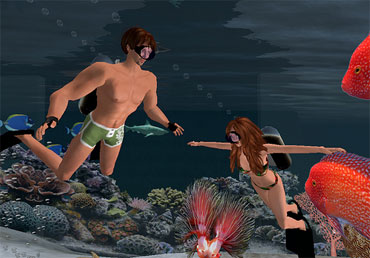
The best that year, he said, was The Carbon Footprint House. Within it, all the appliances glowed with virtual green gas that was proportional to the impact each particular item in the house had in terms of a global carbon footprint. "They had a visualization of green gases oozing out of the appliances," he says. "They even made an introductory movie for people to watch before they went into the house. Those students really hit it out of the park in terms of using all the things people can use in Second Life for a public awareness event."
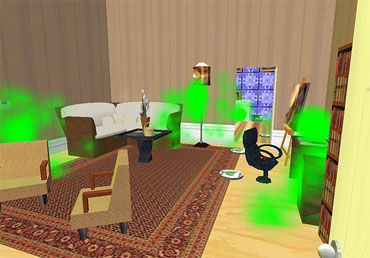
Some builds are far simpler but no less elegant. "What seemed like a minor build made good use of the physics engine," said Crider. "The students showed why stars twinkle and planets don't by having visitors look at stars and planets above the surface of water. The ripple of the water caused stars to twinkle--the atmosphere has enough water that it causes this twinkle. So visitors could see that stars twinkle and why and how only parts of the surfaces of planets have a twinkling appearance."
Taking a tour of Elon's Second Life region allows visitors to see some of the projects left over from last fall. A Zodiac House that debunks the notion that your personality is defined by your sun sign. A demonstration of how the temperatures of stars dictate their colors. A building named "The Coriolis Effect and Your Bathroom: Explaining why the Coriolis Effect does not influence the draining of water." Or basically, the rotation of your water draining has nothing to do with the hemisphere you inhabit.
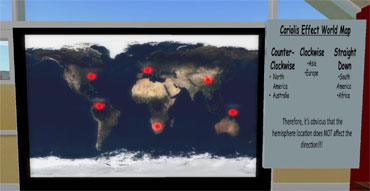
The project that put Elon on the map, so to speak, is the university's simulation of the Apollo 11 moon landing. This recreation of the Apollo 11 site illustrates the layout of the assorted science projects left behind by astronauts during the first manned landing on the Moon. The entire Second Life creation is built to scale and even uses real photos of the craters as well as the flag that was placed that day. Students continue to build projects based on the simulation. 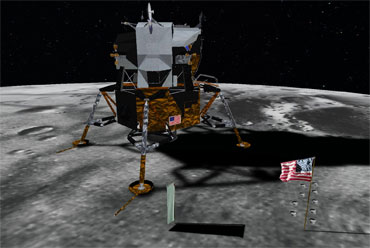
One project was a series of lessons countering the specific arguments some conspiracy theorists make when claiming the moon landing was a hoax. Another student created an authentic layer of lunar dust.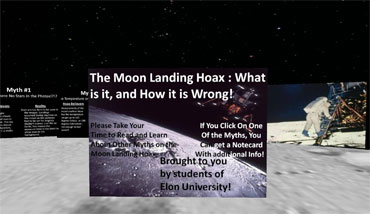
Challenges and Results
Crider said his observation of students and Second Life is that this sort of endeavor may not be ready for mainstream education. "It ends up costing about a week of class time just to get the students used to the program," he said. "I thought over the course of a couple of years I would get better at bringing them in, but I haven't." He added that the different levels of knowledge of how to operate, some already fully familiar and some starting at zero, doesn't help. There are also inherent difficulties of trying to get 30 students registered in a timely fashion and also in trying to keep copies of the creations afterward.
Yet the projects themselves tell a story of success to anyone looking from the outside in at what Elon does with Second Life.
"What impresses people most is when they hear that these projects are built not by science majors or astronomy majors, but by people who may take two science classes in their entire academic careers," he said. "People are impressed by that and also the fact that it is all accomplished by people mostly unfamiliar with Second Life, and done over the course of five weeks."
About the Author
Denise Harrison is a freelance writer and editor specializing in technology, specifically in audiovisual and presentation. She also works as a consultant for Second Life projects and is involved with nonprofits and education within the 3D realm. She can be reached here.